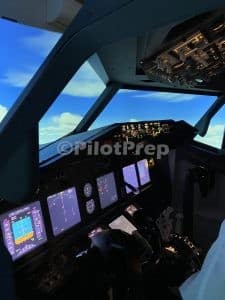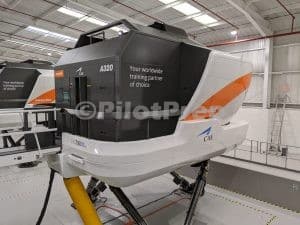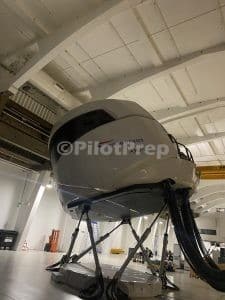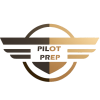What is a Flight Simulator?
Flight simulators are exactly what they say they are. Simulation of flight. Simulators start as basic as phone apps, going all the way to full-motion flight simulators. Simulators that move and are used for commercial airline pilot training (also known as Level D simulators). This article will talk about two types of flight simulators:
- Fixed-based flight simulator
- Full motion flight simulator (Level D simulator)
We’ll look at the differences, and more importantly where you can try them out in the UK! After all, that’s why you’re reading this article.
Fixed Base vs Full Motion Simulator
There are some significant differences between the two types of simulators. Mainly cost!
Fixed Base Simulator
A fixed base simulator is a 1:1 mockup of a real airliner cockpit. They contain all of the buttons, dials, and rotary switches you would expect and also have high fidelity visuals to make the experience feel even more real.
The key disadvantage is that a fixed base simulator, as the name suggests, has a fixed base and doesn’t move. The unit will stay in the same place, so you will feel no accelerations when pulling up or pushing down. This can make some feel a little queasy when taxiing as what you’re seeing and what your body is expecting is not the same. The per-hour cost of a fixed base simulator is significantly cheaper than a full motion simulator. Around 75% cheaper.
If you are a qualified pilot, you can hire these simulators without an instructor and don’t need to be supervised. If you are looking for a flight experience or are not yet a qualified pilot, expect to pay a little extra as you will need someone to operate the simulator and manage the event.

Full Motion Simulator
Much the same as a fixed base simulator but as the name suggests, the unit moves. A full motion simulator is mounted on stilts that are either hydraulically or electrically powered. When you turn left or right, you will feel it as the simulator moves around, quite an impressive thing to watch. These simulators are used during commercial airline pilot training, especially for pilots 6 monthly simulator checks. They are known as Level D simulators and the CAA (Civil Aviation Authority) requires that checks are carried out in a Level D full motion simulator.
The per-hour cost of a full motion simulator is significantly more expensive than a fixed base simulator. You are not only paying for the costs of the simulator itself but also you must be monitored. Therefore someone qualified to operate the simulator will be with you, which adds cost.

Why go to a fixed-based or a full-motion simulator?
Pilot Training
Full and fixed-based flight simulators play a crucial role in pilot training programs. Towards the end of commercial training and before flying a jet airliners for real, a pilot will spend between 48-120 hours in a flight simulator practicing various emergency scenarios to prepare them for real line flying. Airlines, flight schools, and aircraft manufacturers utilize these simulators to train and assess pilots in various scenarios, from routine flights to emergencies. The ability to replicate real-world conditions ensures that pilots are well-prepared for any challenges they face during their day-to-day jobs.
I visit the simulator roughly every 6 months for 2 days at a time, as a legal requirement to maintain my license. During these sessions (4 each year) we practice emergency scenarios, operating procedures, and unique situations that we may not come across in our day-to-day lives. Think de-icing, strong winds, unique airports, challenging scenarios like an engine failure during a go-around at an airfield with high terrain, etc.
Aircraft Development:
Beyond training, full-flight simulators are integral to the development of new aircraft. Engineers and designers use simulators to test and refine the performance of aircraft in a variety of conditions. This iterative process contributes to the creation of safer and more efficient aircraft.
Recreational Use:
For aviation enthusiasts and individuals curious about flying, many flight simulation centers in the UK offer recreational experiences. These facilities provide a taste of what it’s like to be at the controls of a commercial airliner or a fighter jet, making aviation accessible to a broader audience. If you don’t have a large amount of spare cash, a fixed base simulator is fantastic value and offers a real insight into the world of airline flying.
Assessment Preparation
When you move airlines, or sometimes even for your first airline job, you will be required to attend a simulator session. These are usually in full motion simulators and you will be partnered with someone you’ve never met. Your goal is to fly the aircraft safely, and equally importantly, demonstrate your CRM (crew resource management) skills. Most pilots pay to practice in a fixed-based simulator before attending the real assessment. I certainly did! I paid for 4 hours with a friend of mine to prepare for my airline assessments. Expensive? Yes. But I saw it as an investment in my future career and therefore a drop in the ocean.
How much does a fixed-based simulator cost vs a full motion simulator?
Companies differ in their costs and prices and how experienced an instructor you have with you. That said, you can expect to pay around £100-£150 per hour for a fixed-based simulator. You can expect between £400-£600 per hour for a full motion simulator per hour. Now you can see why I suggest fixed-based simulators!
Should I hire a fixed-based or a full-motion simulator?
Unless you are a pilot paying for your own LPC check (license proficiency check), then in almost all cases, a fixed-based simulator is enough. Even if you are preparing for an airline assessment, a fixed base is enough. Unless you specifically want to practice engine failures after take-off (EFATOs) or emergency scenarios that require extensive use of trim, then the visuals and setup are so immersing that you will not notice the lack of motion.
The cost saving is so significant that I truly do not think a full motion simulator is worth it. If you have the funds, then by all means go for full motion but for every 1 hour you get in a full motion simulator, you could have 4 in a fixed-based simulator.

Fixed-based simulators in London and the UK
Below is a list of fixed-based simulators in the UK. I have personally used three of them and recommend them wholeheartedly. As a disclaimer, the two I recommend do have affiliate links, the very small amount I receive helps pay for this website’s costs and keep the content free so I don’t have to lock it behind a paywall. If I haven’t used a simulator, the links are not affiliate. I appreciate it if you choose to attend the simulators I recommend, please could you use the affiliate links.
There are lots of fixed and full-motion simulators in the UK. All simulators listed below have been used by friends and colleagues of mine and are therefore recommended. If a simulator isn’t on this list, it’s because either myself or my friends and colleagues have never been and therefore cannot recommend them without experience.
Simulators I’ve used and recommend
Flightpad (Boeing) – Ealing, London
Flight Simulator Midlands (Boeing and Airbus) – Coventry
VA Airline Training (Boeing and Airbus) – Cambridge
Simulators my friends and colleagues have used and recommend
Motion Flight Training (Boeing and Airbus) – Gatwick
